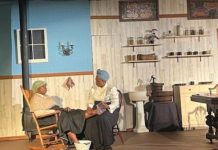It’s 1939 and film studio chief David O. Selznick has staked his career on adapting Margaret Mitchell’s bestselling novel Gone with the Wind for the screen. Still, Selznick shuts down production after five weeks. Neither Director George Cukor nor the screenwriter “got it.” Screenwriter and Playwright Ron Hutchinson’s farce Moonlight and Magnolias provides a comic retelling of what happens next. Director Ilene Chalmers and four veteran actors bring audiences to the center of the action in Laurel Mill Playhouse’s current production of Moonlight and Magnolias.

Thom Eric Sinn provides a stunning performance as Selznick, who is in debt up to his eyeballs and fighting his unsuccessful father’s ghost as he struggles to produce Gone with the Wind. Facing utter ruin, Selznick calls in Ben Hecht (Gene Valendo) to rewrite the script and reassigns Victor Fleming (Fred Nelson), who had been working on The Wizard of Oz, to direct this movie. Forget the rumors; Fleming says he only slapped Judy Garland once.
The roles of Selznick, Hecht, and Fleming are based on historical figures. This play adds a secretary, Miss Poppenghul (Stephanie Ichniowski), who stays near the office while the men are locked inside for five days, surviving on peanuts and bananas.
Moonlight & Magnolias captures what might have happened in that room. For one thing, Hecht had not read the book. Fleming and Selznick do their best to act out the book for the writer.
The scenes where Fleming and Selznick act out Gone with the Wind for Hecht provide ample opportunities for off-color physical comedy, and LMP’s cast is up for the task. Picture Fleming bent over picturing a scene with Selznick close, very close, behind the director when Miss Poppenghul enters the room unannounced. Or Fleming, playing the role of Melanie, laying on the floor pushing in labor with Selznick, now playing Scarlett, in between Melanie’s legs waiting to catch the baby.
Scarlett puts the labor on hold (you know how bossy she is), then moves to another room wondering where slave girl Prissy is with the doctor. This gives Fleming, now playing Prissy, an opportunity to skip across the stage to Scarlett who will slap her for lying and tattling. This is too much for the socially conscious Hecht, who can’t fathom putting the scene where Scarlett slaps Prissy on film in 1939 as the threat of Nazi Germany loomed over Europe.

During the scene, Valendo does a mind-blowing job of portraying Jewish victimhood. The Hecht character hints at this throughout the production. The comedy gets dramatic for a few minutes. Hecht, who was a Zionist in real life, believes neither he nor any Jew in this country can be an American. They will always be seen as others. He goes to an absurd length to pull Selznick into Hecht’s reality. The scene is resolved with Hecht writing the scene his way several times. Nelson, as Gone with the Wind‘s Director Fleming, helps to bring the spirit to comedy through his enthusiastic responses to Hecht’s writing his way.
Thomas Plott is credited as the fight choreographer and Ichniowski as fight captain. Considering all the smacking, wrestling and physical action taking place, they both did an excellent job. Not a single actor was reported killed or injured in the making of this play.
Chalmers and Sascha Nelson designed the wonderful set. It includes black-and-white glossies of several stars of the day hanging on the wall, a loveseat stage right that figured into the action, two desks and room for the actors to move. Chalmers made use of everything.
Nelson’s costumes proved versatile as each day went by and shirttails became untucked, or ties found other uses. Time was also recognized by the number of banana peels and peanuts on the floor and furniture.
I love historical pieces that allow audience members to think about life in another time and how they might have reacted to challenges. Under Chalmers’ skillful direction, LMP’s cast draws the audience into the challenges and melodrama faced by Selznick, Fleming, and Hecht in 1939 as they worked to extinguish their inner fears to create the beginning for a film that would win 10 Oscars — all while keeping the audience laughing with well-executed physical comedy.
Running Time: One hour and 53 minutes, with a 10-minute intermission.
Moonlight & Magnolias plays through March 15, 2020, at the Laurel Mill Playhouse, 508 Main St. Laurel, MD. For tickets, call the box office 301-617-9906, or go online.
Note: The play contains profanity, and may not be suitable for those with severe peanut allergies, as large quantities of peanuts are eaten onstage.




